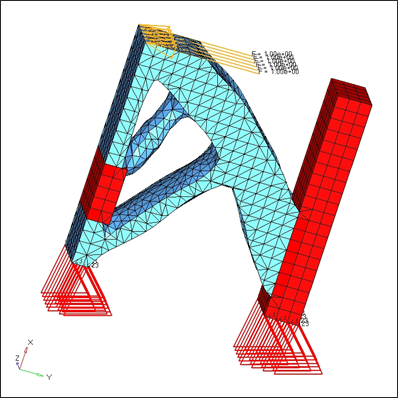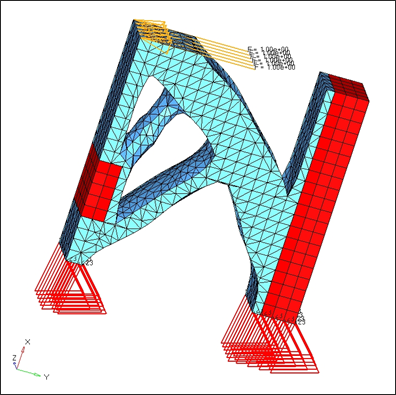FEA Topology for Reanalysis |

|

|

|

|
|
FEA Topology for Reanalysis |

|

|

|

|
The purpose of this functionality is to provide an iso-density surface based on the volumetric density information from a topology optimization. Through tetrameshing for 3-D models and inheriting boundary conditions, the results from FEA topology can be used for quick reanalysis.
FEA topology can handle both shell and solid elements. For 3-D models, the recovered iso-surface can be tetrameshed-by-property automatically. FEA topology provides two options for the processing of non-design elements: Keep smooth narrow layer around and Split all quads. Keep smooth narrow layer around will retain an artificial layer of elements around the non-design space in the interpretation, and Split all quads will split quad elements in the non-design space, if present, to generate a tetra connection between design and non-design regions. Finally, FEA topology preserves boundary conditions by inheriting them from the original model (<prefix>.fem). Those boundary conditions unattached to nodes/elements after geometry recovery are deleted to ensure reanalysis.
An example of FEA topology for reanalysis is shown below with the following input data definition:
file |
block |
density threshold |
0.300 |
Keep smooth narrow layer around |
off |
Split all quads |
on |

Result of FEA topology for reanalysis
The same model is run, this time with Keep smooth narrow layer around on, and Split all quads off. This approach creates a layer of elements around the non-design region and pyramids around the quad elements, if quads exist, to connect to the design space tetrahedral elements.

Result of FEA topology with a layer of elements around non-design space
Tetramesh will be applied on the iso-surface result if there is one close volume at least. The advantages of the tetramesh in FEA topology include:
| • | Tetramesh can be performed by property. |
| • | The flexibility of controlling the number of tetramesh retries by perturbing the density threshold value, in cases where tetramesh sometimes fails. |